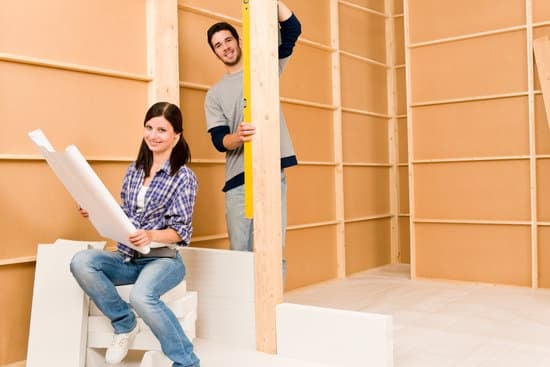Are you wondering what receipts count for home improvement? Understanding which expenses qualify as home improvement can help you keep track of your receipts and maximize any potential tax benefits. Whether you are renovating, repairing, or making upgrades to your home, it is important to know which receipts are essential for documenting your expenses.
When it comes to home improvement projects, keeping accurate records of your expenses is crucial. In this article, we will explore the different types of receipts that are important to hold onto when undertaking various home improvement projects. From materials and labor to permits and design services, we will break down the key receipts that you should keep organized for tax and documentation purposes.
Receipts for materials and supplies will play a significant role in documenting your home improvement expenses. Moreover, tracking receipts for labor and contractor services will also be vital in ensuring that you have all the necessary documentation for your project. Additionally, obtaining receipts for permits, inspections fees, equipment rentals, and architectural services are all part of the puzzle when it comes to recording your home improvement costs.
If you’re looking to improve energy efficiency in your home or tackle maintenance and repair services, specific receipts will be essential. By understanding what receipts count for home improvement, you can set yourself up for success throughout the entire process.
Receipts for Materials and Supplies
When it comes to home improvement expenses, keeping track of receipts is crucial for ensuring that you can accurately report and potentially deduct these expenses on your taxes. But what exactly counts as a receipt for home improvement? This section will break down the types of receipts that count for material and supplies used in home improvement projects.
Materials and supplies are often the most significant expenses when it comes to home improvement projects. Keeping track of receipts for these items is essential for budgeting and tax purposes. Here are the types of receipts that count for materials and supplies:
- Receipts from hardware stores: Any purchases made at hardware stores such as Home Depot, Lowe’s, or local hardware stores can count as valid receipts for materials and supplies.
- Invoices from lumber yards: If you purchase lumber, plywood, or other building materials from a lumber yard, be sure to keep the invoices as they will serve as valid receipts.
- Online purchase confirmations: If you order materials and supplies online from retailers like Amazon, Wayfair, or specialty home improvement websites, the purchase confirmation emails or invoices will count as valid receipts.
It’s important to note that any receipts for materials and supplies should include detailed information such as the date of purchase, itemized list of what was purchased, quantity, price per unit, total amount, and the name/address of the store or supplier. Keeping organized records of these receipts will help you accurately report your expenses related to home improvement projects.
Receipts for Labor and Contractor Services
When tackling home improvement projects, labor and contractor services are often a significant portion of the expenses. In order to properly track and document these costs, it is essential to understand what receipts count for labor and contractor services.
Invoice or Contract Documentation
One of the most crucial receipts for labor and contractor services is the invoice or contract documentation provided by the hired professionals. This should include a detailed breakdown of the services provided, the timeline for completion, and the agreed-upon pricing. It is important to retain these documents as they serve as proof of the work done and the associated expenses.
Receipts for Subcontractors
In cases where subcontractors are hired to work on specific aspects of a home improvement project, their receipts also count towards labor and contractor services. Whether it’s electrical work, plumbing, or other specialized tasks, maintaining records of payments made to subcontractors is vital for accurately accounting for these expenses.
Proof of Payment
In addition to invoices and contracts, proof of payment such as bank statements or canceled checks should be kept as further evidence of the money spent on labor and contractor services. This additional documentation can help support any claims or deductions related to home improvement expenses during tax filing.
Understanding what receipts count for labor and contractor services is crucial in accurately documenting and justifying these expenses when undertaking home improvement projects. By ensuring thorough record-keeping and retention of relevant documentation, homeowners can effectively track their costs and potentially benefit from tax deductions or credits related to their home improvements.
Receipts for Permits and Inspection Fees
When it comes to home improvement projects, obtaining the necessary permits and paying for inspection fees is an essential part of the process. These costs are typically considered eligible expenses when it comes to claiming deductions or tax credits, but it’s important to understand what receipts count for home improvement in this category.
First and foremost, any receipts related to building permits should be carefully saved and documented. Whether you’re making structural changes, adding a new room, or upgrading major systems such as electrical or plumbing, the permits you obtain will come with associated fees that can often be included in your overall home improvement expenses.
In addition to building permits, receipts for inspection fees should also be retained for record-keeping purposes. These fees are often paid at various stages of a project, such as before work begins, during critical phases of construction, and upon completion. It’s crucial to track these costs and save the receipts in case you need to provide proof of expenses for tax or insurance purposes.
It’s worth noting that not all renovation projects may require permits or inspections, especially if they are more cosmetic in nature. However, for any substantial improvements that involve structural changes or alterations to systems within your home, keeping thorough records of permit and inspection-related expenses is essential.
By doing so, you’ll have a clear understanding of what receipts count for home improvement in this category and ensure that you’re able to accurately account for these costs when the time comes to report them.
| Expenses | Considerations |
|---|---|
| Building Permits | Include fees associated with major structural changes or system upgrades. |
| Inspection Fees | Save receipts for inspections conducted at various stages of a project. |
Receipts for Equipment and Tool Rentals
When it comes to home improvement, sometimes the tools required are not something you typically have lying around in your garage. In these cases, you may need to rent equipment or tools to complete the project. The good news is that receipts for equipment and tool rentals can be considered as valid expenses for home improvement projects.
Whether you are renting heavy machinery for a landscaping project or power tools for a renovation, these receipts can be used to prove the cost of the necessary tools and equipment for your home improvement project. These costs can add up quickly, so it’s important to keep track of all rental receipts for tax purposes.
It’s important to note that only the actual cost of renting the equipment or tools will be considered as an expense. Any additional fees such as delivery charges or damage waivers may not count towards the home improvement expense. Keep this in mind when keeping track of your rental receipts.
| Expenses | Receipts |
|---|---|
| Equipment Rental | $500 |
| Tool Rental | $300 |
Receipts for Design and Architectural Services
When it comes to home improvement projects, design and architectural services play a crucial role in the overall outcome of the work. Whether you are planning a major renovation or a simple remodeling project, it is important to keep track of your expenses and ensure that you have all the necessary receipts for design and architectural services.
Here is a breakdown of the types of receipts that count for home improvement when it comes to design and architectural services:
- Initial consultation fees: Any fees paid for the initial consultation with a designer or architect should be documented and retained as part of your home improvement expenses.
- Design concept and blueprint fees: If you hire a professional to create design concepts or blueprints for your home improvement project, make sure to keep all receipts related to these services.
- 3D renderings and virtual tours: In some cases, homeowners may opt for 3D renderings or virtual tours of their proposed renovations. Any payments made for these services should also be included in your records.
- Architectural drawings and plans: The creation of detailed architectural drawings and plans is essential for any construction or remodeling project. Be sure to retain receipts for any expenses related to this aspect of the design process.
Keeping these receipts organized and readily available not only helps you stay on top of your budget but also ensures that you have proper documentation for tax purposes. Additionally, having a clear record of design and architectural expenses can be valuable if any issues arise during or after the completion of your home improvement project.
By understanding which receipts count for home improvement in this category, you can effectively manage your finances and verify the quality of work provided by design professionals.
Receipts for Energy Efficient Upgrades
Energy efficient upgrades are a great way to not only improve the value of your home but also reduce energy costs in the long run. When it comes to tax deductions and credits, it is important to keep track of all receipts related to these types of upgrades.
Receipts for Insulation and Weather Stripping
Receipts for purchases of insulation and weather stripping materials can be used to claim a tax credit for energy efficient upgrades. These materials help improve the overall energy efficiency of your home by keeping cold air out in the winter and cool air in during the summer. Be sure to keep track of all receipts for these purchases, as they may qualify for tax benefits.
Receipts for Energy Star Appliances
Purchasing Energy Star certified appliances is another way to make your home more energy efficient. Keep all receipts related to these purchases, as they may qualify for tax credits. These appliances are designed to use less energy, which not only saves you money on utility bills but can also provide a benefit at tax time.
Receipts for Solar Panels and Renewable Energy Systems
Investing in solar panels or renewable energy systems can have a significant impact on both your energy bills and the environment. It’s essential to keep track of all receipts related to the purchase and installation of these systems, as they often qualify for significant tax credits or deductions.
Overall, keeping detailed records of all receipts related to energy efficient upgrades is crucial when it comes to claiming any potential tax benefits. It’s important to consult with a tax professional or accountant to ensure that you are following all necessary guidelines and regulations regarding what receipts count for home improvement expenses related to energy efficiency.
Receipts for Home Maintenance and Repair Services
Home maintenance and repairs are essential for maintaining the value and integrity of your home. When it comes to tax deductions and credits, it’s important to understand what receipts count for home improvement in this category.
Receipts for home maintenance and repair services can include a wide range of expenses, such as plumbing repairs, HVAC maintenance, roof repairs, electrical work, and other similar services. These receipts are important to keep track of because they can potentially be used to claim deductions or credits on your taxes.
It’s important to note that not all home maintenance and repair expenses may qualify for tax benefits. For example, routine maintenance like regular air filter changes or pest control treatments generally do not qualify. However, if the maintenance or repair is considered a necessary expense to keep your home in good working condition, then it may be eligible for tax benefits.
When keeping track of receipts for home maintenance and repair services, ensure that you have detailed documentation of the work performed and the cost associated with it. This includes invoices from service providers, receipts for any materials or parts used in the process, and any permits or inspection fees related to the work done. All of these documents will be necessary when preparing your taxes and determining what expenses can count towards home improvement deductions.
Receipts for Landscaping and Outdoor Improvement Projects
In conclusion, keeping track of receipts for home improvement projects is essential for various reasons. Not only do they help you stay organized and on budget, but they also serve as important documentation for tax purposes and potential future home sales. It’s important to understand what receipts count for home improvement, as different expenses may be deductible or qualify for tax credits.
Receipts for materials and supplies, labor and contractor services, permits and inspection fees, equipment and tool rentals, design and architectural services, energy-efficient upgrades, home maintenance and repair services, as well as landscaping and outdoor improvement projects all play a significant role in documenting the expenses related to your home improvement endeavors.
By holding onto these receipts, homeowners can ensure that they are accurately accounting for their expenditures while also potentially benefiting financially through deductions or credits. Whether it’s a DIY project or a professional service hired to make improvements to your property, the receipts obtained from these transactions are invaluable in proving the legitimacy of your home improvement expenses.
Frequently Asked Questions
What Does the IRS Consider Home Improvements?
The IRS considers home improvements as any project that adds value to your home, prolongs its useful life, or adapts it to new uses. This can include renovations, adding a swimming pool, or installing a new heating system.
How Do You Prove Home Improvements Without Receipts?
To prove home improvements without receipts, you can use bank statements, credit card statements, and invoices from contractors. You can also provide photographs and detailed records of the work done to support your claim.
What Improvements Count as Cost Basis?
Improvements that count as cost basis are those that increase the value of your property, such as additions, landscaping, and major upgrades to the home’s systems (e.g., electrical, plumbing). These improvements can be used to reduce capital gains tax when you sell the property.

I’m thrilled to have you here as a part of the Remodeling Top community. This is where my journey as an architect and remodeling enthusiast intersects with your passion for transforming houses into dream homes.





